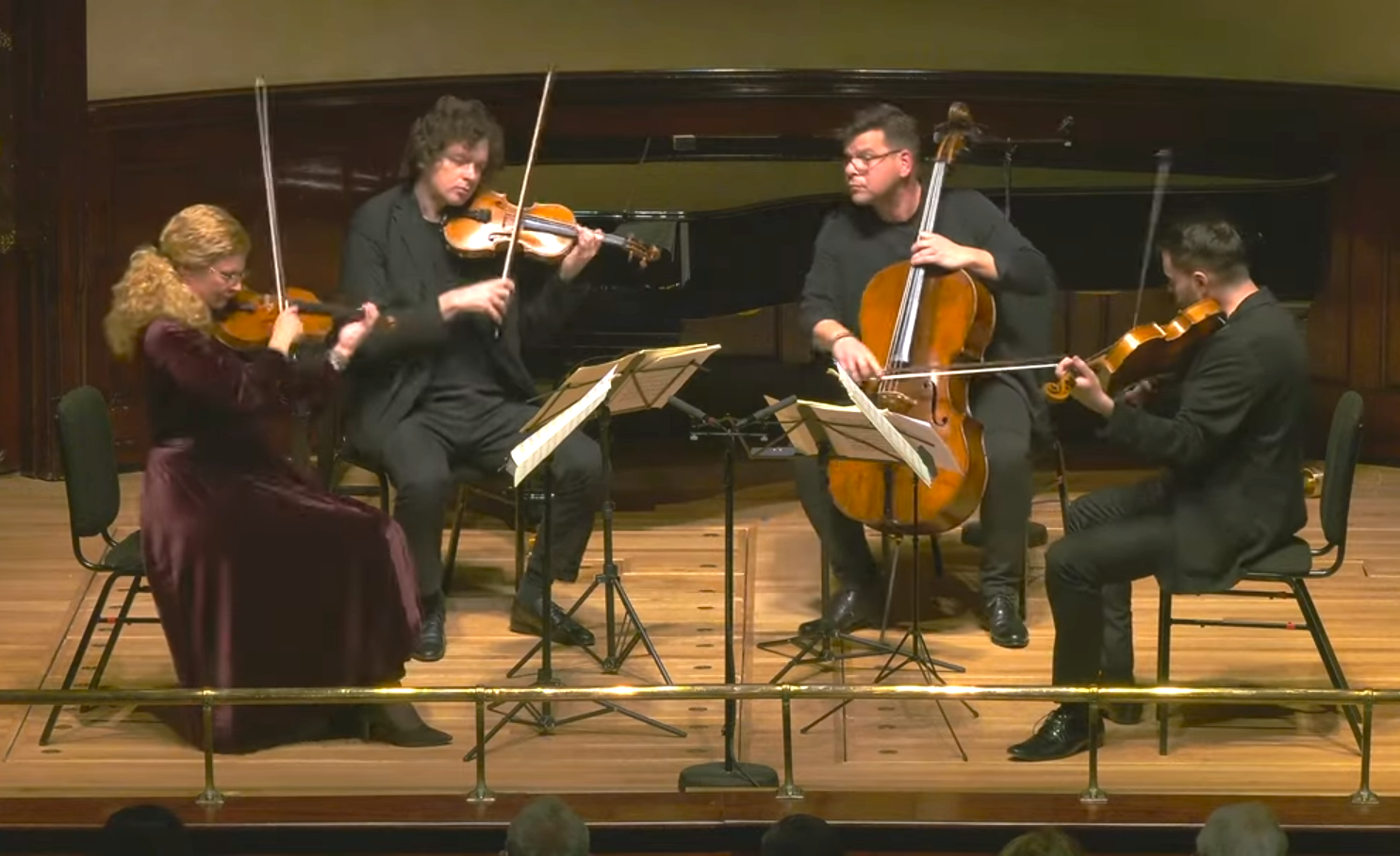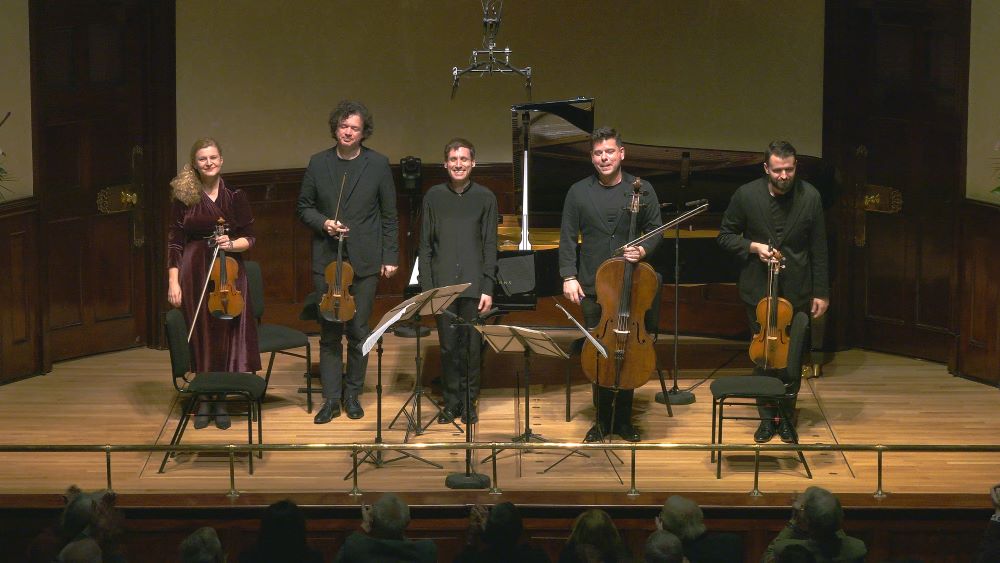Serious realisation of the seven often thorny Martinů string quartets is a major undertaking. When I spoke to Veronika Jarůšková and Peter Jarůšek after an East Neuk Festival concert, they said they intended to do it slowly, with absolute commitment. Tuesday night’s performance of the stupendous Fifth sealed the pledge. It held central place in a concert which only brought relief from Czech grittiness with the great cathartic melodies in Brahms’s Third Piano Quartet.
Every performance by "the Pavel Haases" blends searing energy with supreme refinement, and this was no exception; with regular collaborator Boris Giltburg joining them for the Brahms, there could be no dynamic limits at either end of the scale. The ferocity they brought to parts of Schulhoff's Five Pieces for String Quartet transcended the fashionable dissonances of the 1920s, when he composed them, and seemed to more than hint at dances of death (Schulhoff died before he could meet the fate of Pavel Haas and others, gassed at Auschwitz, his life terminated by tuberculosis in Wülzburg's prison-fortress in 1942). Though the audience laughed at several witty movement endings, the "Alla Valse viennese", initiated by a striking viola solo from Šimon Truszka, was imbued with an acid sense of the macabre, and the "Alla Tango milonga" was poised on a knife edge, finishing with an ambiguous, chilling chord. In the final "Alla Tarantella," I was reminded most of the increasingly fraught treatment of the dance by Schubert in the massive finale of his C minor Sonata, D958.  Martinů's Fifth Quartet struck very much as an expression of his anguished feelings in 1938, when he had just returned from what would turn out to be his last visit to his native Czechia to witness the premiere of his operatic masterpiece Juliette/Julietta. He had also embarked on an affair with the brilliant young composer and conductor Vítězslava Kaprálová, dedicating the work to her but witholding publication until shortly before his death. Though it quotes a song of hers, the Fifth is not just about that relationship, contrary to current hunches, and it never settles to joy (the emanciipation of the "Julietta cadence" is nowhere to be found here, though Martinů used it so often in his works following the untimely death of Kaprálová, which haunted him for the rest of his life - something that could never be revealed in words owing to his marriage).
Martinů's Fifth Quartet struck very much as an expression of his anguished feelings in 1938, when he had just returned from what would turn out to be his last visit to his native Czechia to witness the premiere of his operatic masterpiece Juliette/Julietta. He had also embarked on an affair with the brilliant young composer and conductor Vítězslava Kaprálová, dedicating the work to her but witholding publication until shortly before his death. Though it quotes a song of hers, the Fifth is not just about that relationship, contrary to current hunches, and it never settles to joy (the emanciipation of the "Julietta cadence" is nowhere to be found here, though Martinů used it so often in his works following the untimely death of Kaprálová, which haunted him for the rest of his life - something that could never be revealed in words owing to his marriage).
Jarůšková pushed high-lying expressivity to the limits, while harsh pizzicati and other effects from her colleagues undermined and impeded the Adagio's attempts at heartease. The finale has plenty of energy - astonishing at one point to see Jarůšek rocking his cello from side to side - but no release. Tonality settles in chords, but minor ones. An uneasy masterpiece, standing in relation to Martinů's quartet series as Bartók's Fourth does to his.  The relief we needed came some way in to the first movement of Brahms's Third PIano Quartet, much the least often heard of the three, in the shape of a radiant second subject, and later the pure song of the Andante, which starts like a cello sonata (violin and piano kick off the finale). But this is a more often turbulent early inspiration, parallel to the mighty First Piano Concerto, later recollected and reworked, but not in tranquillity. That Boris Giltburg was able to thunder explosions and double octaves was thanks only to the equal attack of the world's most febrile string quartet: what a perfect team they make. And what a final, decisive journey into light was the encore, the Scherzo-Furiant from Dvořák's Second Piano Quintet, with second violinist Marek Zwiebel joining the rest. Life-enhancing.
The relief we needed came some way in to the first movement of Brahms's Third PIano Quartet, much the least often heard of the three, in the shape of a radiant second subject, and later the pure song of the Andante, which starts like a cello sonata (violin and piano kick off the finale). But this is a more often turbulent early inspiration, parallel to the mighty First Piano Concerto, later recollected and reworked, but not in tranquillity. That Boris Giltburg was able to thunder explosions and double octaves was thanks only to the equal attack of the world's most febrile string quartet: what a perfect team they make. And what a final, decisive journey into light was the encore, the Scherzo-Furiant from Dvořák's Second Piano Quintet, with second violinist Marek Zwiebel joining the rest. Life-enhancing.














Add comment